9 Sculpture and Installation
Drawing and painting both fall into the category of two-dimensional art; sculpture is three-dimensional in that it has height, width, and depth. It has mass, one of the elements of art. We include in the sculptural section other types of art that may not obviously belong to either category – installation art is one of those. Artists sometimes create entire environments in a museum or gallery – or elsewhere – that the viewer is intended to experience corporally (with their bodies) and sometimes with all of the senses. Another group of artists create work out of nature itself. Land artists like Robert Smithson made both the material of the natural world like water, soil and rocks their medium, but also made ideas and concepts like entropy the subject of the work. We will look at examples of three-dimensional artwork in this section.
Methods
Carving
Carving uses the subtractive process to cut away areas from a larger mass, and is the oldest method used for three-dimensional work. Traditionally stone and wood were the most common materials because they were readily available and extremely durable. Contemporary materials include foam, plastics and glass. Using chisels and other sharp tools, artists carve away material until the ultimate form of the work is achieved.
The Moai massive stone sculptures carved by the Rapa Nui people on Easter Island in Polynesia between the years 1250 and 1500.1 These figures were positioned to face inland and are thought to have represented the guardian ancestors/deities that watched over the island and its people. The process of carving such large figures and transporting and placing them was a feat for these early peoples not unlike the creation of Stonehenge in England or the Olmec heads of ancient Mexico.

In another example, you can see the high degree of relief carved from an original wood block in this mask from the Pacific Northwest Coast Kwakwaka’ wakw culture. The mask was used in winter ceremonies where animals were said to take human form.
It’s extraordinary for masks to personify a natural event. This and other mythic figure masks are used in ritual and ceremony dances. The broad areas of paint give a heightened sense of character to this mask.

Michelangelo’s masterpiece, David, from 1501 is carved from a single block of marble, finished and polished to embody an idealized form which was a testament to human aesthetic brilliance.

Three Types of Carved Sculpture
We think of carved sculpture as falling into three basic types: in-the-round, high relief, and low (bas) relief. Michelangelo’s David above is an example of sculpture in-the-round. This is fairly easy to spot as one can actually walk all around the sculpture and it is finished on all sides. High relief sculpture is usually a decorative addition to another object, often architecture.

High relief sculpture is characterized by figures or elements that are significantly raised off the surface from which they are carved, but still remain attached. You can see very dark shadows around the figures in high relief – note the black shadows around the urn on the bottom of the sculpture above.
Low relief, too, is most often seen on architecture. In low, or bas as in the French term, relief, few very dark shadows are seen.
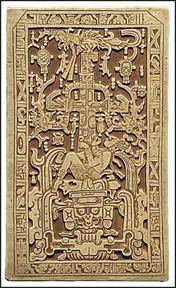
Casting
The additive method of casting has been in use for over five thousand years. It’s a manufacturing process by which a liquid material is usually poured into a mold, which contains a hollow cavity of the desired shape, and then allowed to solidify. One traditional method of bronze casting frequently used today is the lost wax process. Modern casting materials are usually metals but can be various cold setting materials that cure after mixing two or more components together; examples are epoxy, concrete, plaster, and clay. Casting is most often used for making complex shapes that would be otherwise difficult or uneconomical to make by other methods. It’s a labor-intensive process that today allows for the creation of multiples from an original object (similar to the medium of printmaking), each of which is extremely durable and exactly like its predecessor. In the ancient world the mold would of necessity be destroyed once the sculpture had been cast. Today molds are made from materials that can be reused, but a mold is usually destroyed after the desired number of castings has been made. Traditionally, bronze statues were placed atop pedestals to signify the importance of the figure depicted. A statue of William Seward (below), the U. S. Secretary of State under Abraham Lincoln and who negotiated the purchase of the Alaska territories, is set nearly eight feet high so viewers must look up at him. Standing next to the globe, he holds a roll of plans in his left hand. We generally refer to these kinds of commemorative likenesses as “statues” while figures in other contexts are usually called “sculpture.”

More contemporary bronze cast sculptures reflect their subjects through different cultural perspectives. The statue of rock guitarist Jimi Hendrix is set on the ground, his figure cast as if performing on stage. He’s on both of his knees, head thrown back, eyes shut and mouth open in mid wail. His bell-bottom pants, frilly shirt unbuttoned halfway, necklace and headband give us a snapshot of 1960’s rock culture but also engage us with the subject at our level.
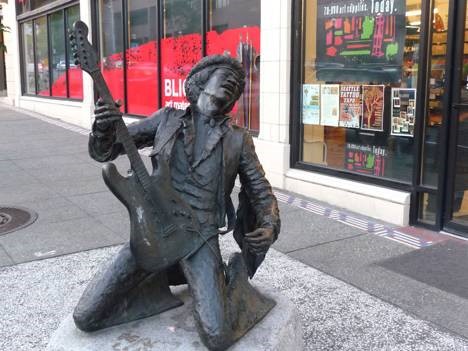
Modeling
Modeling is a method that can be both additive and subtractive. The artist uses modeling to build up form with clay, plaster or other soft material that can be pushed, pulled, pinched, carved or poured into place. The material then hardens into the finished work. Larger sculptures created with this method make use of an armature, an underlying structure of wire that sets the physical shape of the work. Although modeling is primarily an additive process, artists often do remove material in the process. Modeling a form is often a preliminary step in the casting method. In 2010, Swiss artist Alberto Giacometti’s Walking Man (c. 1955), a bronze sculpture first modeled in clay, set a record for the highest price ever paid for a work of art at auction. Here you see another version of that sculpture belonging to the National Gallery in Washington, D.C. Giacometti was known for his elongated abstract figures. One of his inspirations was Etruscan art which we will look at in a later section.

This Mayan Woman and Child were modeled from clay and then fired to create a ceramic figure. It may have been polychromed (painted with 2 or more colors).

Construction/Assemblage
Construction, or assemblage, uses found, manufactured or altered objects to build form. Artists weld, glue, bolt and wire individual pieces together to create a new and unique form. Duchamp’s Readymades are the historical predecessors for this type of work, as are Rauschenberg’s Combines from the 1950’s. Contemporary artists bring not only form but theory to their work in this technique. Our example here is Jessica Stockholder.
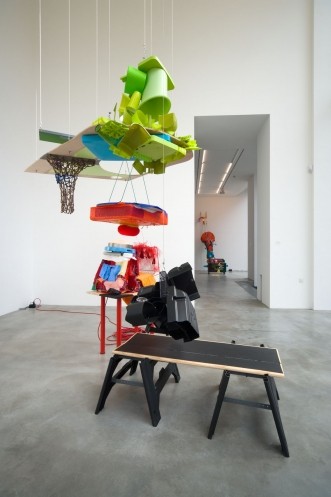
Stockholder is originally from Seattle; her pieces are created from objects that individually might be overlooked, or seen only as utilitarian. Stockholder is drawn to the potential in these objects through color and form. She also relates her structures to the physical human body and our own interaction with objects in space. We have discussed the emotional implications of color in the viewers’ reaction to art. Stockholder has written that this is one of her concerns as well: “Color evokes feeling; I am not sure why, but I do know that it does. I work with color, form and composition exploring the links between emotive and thoughtful response. My works provide an opportunity to reify internal mind/feeling space. For a moment the abstract insubstantial nature of feeling/thoughts can be experienced as external and embodied by material.” From the artist’s website: https://jessicastockholder.info/about/
Both playful and ironic, Stockholder’s pieces are accessible and visually stimulating; they are an excellent example of the art of assemblage.
Sculptor Debra Butterfield transforms throw away objects into abstract sculptures of horses with scrap metal, wood and other found objects. Sometimes she also casts these constructions in bronze, but the original form made of various materials is assembled. Frequently she uses reclaimed materials to create the sculpture. Riot, a work from 1990 is made of pieces of found metal assembled into the final shape.
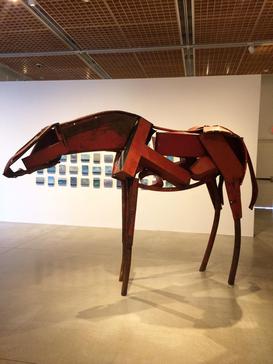
Louise Nevelson is another American artist who used cut and shaped pieces of wood, gluing and nailing them together to form fantastic, complex compositions. Painted a single tone, (usually black or white), her sculptures are graphic, textural facades of shapes, patterns and shadow.
Traditional African masks often combine different materials. The elaborate Kanaga Mask from Mali uses wood, fibers, animal hide and pigment to construct an other worldly visage that changes from human to animal and back again. You can see the example from the Met in New York at this url: https://www.metmuseum.org/art/collection/search/315061
Movement
Some modern and contemporary sculptures incorporate movement, light and sound. Kinetic sculptures use ambient air currents or motors allowing them to move, changing in form as the viewer stands in place. The artist Alexander Calder is famous for his mobiles, whimsical, abstract works that are intricately balanced to move at the slightest wisp of air, while the sculptures of Jean Tinguely are contraption-like and, similar to Nevelson’s and Butterfield’s works, constructed of scraps often found in garbage dumps. His motorized works exhibit a mechanical aesthetic as they whir, rock and generate noises. Tinguely’s most famous work, ‘Homage to New York‘, ran in the sculpture garden at New York’s Museum of Modern Art in 1960 as part of a performance by the artist. After several minutes, the work exploded and caught fire, as it was supposed to do. The New York City fire department, however, was not amused.
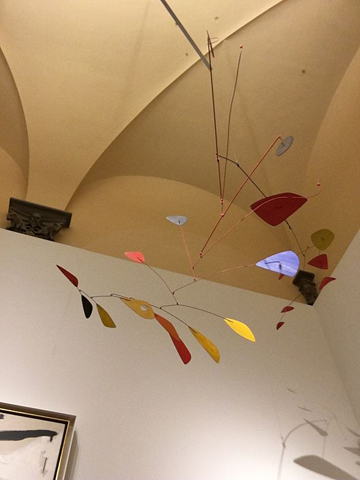
The idea of generating sound as part of three-dimensional works has been utilized for hundreds of years, traditionally in musical instruments that carry a spiritual reference. Contemporary artists use sound to heighten the effect of sculpture or to direct recorded narratives. The cast bronze fountain by George Tsutakawa (below) uses water flow to produce a soft rushing sound. In this instance the sculpture also attracts the viewer by the motion of the water: a clear, fluid addition to an otherwise hard abstract surface.

Doug Hollis’s A Sound Garden from 1982 creates sounds from hollow metal tubes atop grid like structures rising above the ground. In weather vane fashion, the tubes swing into the wind and resonate to specific pitch. The sound extends the aesthetic value of the work to include the sense of hearing and, together with the metal construction, creates a mechanical and psychological basis for the work. There is a video of the work here:
Modern Variations of Three-Dimensional Media
Dan Flavin is one of the first artists to explore the possibilities of light as a sculptural medium. Since the 1960s his work has incorporated fluorescent bulbs of different colors and in various arrangements. Moreover, he takes advantage of the wall space the light is projected onto, literally blurring the line between traditional sculpture and the more complex medium of installation.
Installation Art
Installation art utilizes multiple objects, often from various mediums, and takes up entire spaces. It uses a space and everything in it as the work of art, and is experienced by your entire body. It can be generic or site specific. Because of their relative complexity, installations can address aesthetic and narrative ideas on a larger scale than traditional sculpture. Its genesis can be traced to the Dada movement, ascendant after World War I and which predicated a new aesthetic by its unconventional nature and ridicule of established tastes and styles. Sculpture came off the pedestal and began to transform entire rooms into works or art. Kurt Schwitters’ Merzbau, begun in 1923, transforms his apartment into an abstract, claustrophobic space that is at once part sculpture and architecture. With installation art the viewer is surrounded by and can become part of the work itself.
Here is a video on Vimeo of the reconstruction of the Merzbau at the Berkeley Art Museum in 2011:
British artist Rachel Whiteread’s installation Embankment from 2005 fills an entire exhibition hall with casts made from various sized boxes. At first appearance a snowy mountain landscape navigated by the viewer is actually a gigantic nod to the idea of boxes as receptacles of memory towering above and stacked around them, squeezing them towards the center of the room. Whiteread uses epoxy and other polymers to cast her sculpture. This installation would qualify as both cast sculpture and installation art. Whiteread’s work often deals with memory and loss.

Ilya Kabakov mixes together a narrative of political propaganda, humor and mundane existence in his installation The Man Who Flew Into Space From His Apartment from 1984. What we see is the remains of a small apartment plastered with Soviet era posters, a small bed and the makeshift slingshot a man uses to escape the drudgery of his life within the system. A gaping hole in the roof and his shoes on the floor are evidence enough that he made it into space. See a slide presentation of this work at: https://www.wikiart.org/en/ilya-kabakov/the-man-who-flew-into-space-from-his-apartment-1984
Performance Art
Performance art goes a step further, involving the artist as part of the work itself. Some performance artworks are interactive, involving the viewer too. The nature of the medium is in its ability to use live performance in the same context as static works of art: to enhance our understanding of artistic experience. Similar to installation works, performance art had its first manifestations during the Dada art movement, when live performances included poetry, visual art and music, often going on at the same time.
The German artist Joseph Beuys was instrumental in introducing performance art as a legitimate medium in the post World War II artistic milieu. I Like America and America Likes Me from 1974 finds Beuys co-existing with a coyote for a week in the Rene Block Gallery in New York City. The artist is protected from the animal by a felt blanket and a shepherd’s staff. Performance art, like installation, challenges the viewer to reexamine the artistic experience from a new level.

In the 1960’s Allen Kaprow’s Happenings invited viewers to be the participants. These events, sometimes rehearsed and other times improvised begin to erase the line between the artist and the audience. Yoko Ono’s ‘Cut Piece‘ from 1965 specifically invites members of the audience to interact with her on stage. You can watch the Maysle brothers’ video of a portion of this event on Youtube:
This same idea – using the artist’s body as subject, is evident in the performance art of Marina Abramovic. In The Artist is Present she sits quietly as individual visitors sit across the table from her, exchanging silent glances and stares.
Today we see a new form of performance art happen unexpectedly around us in the form of Flash Mobs: groups of people who gather in public spaces to collaborate in short, seemingly spontaneous events that entertain and surprise passersby. Many flash mobs are arranged in advance through the use of social media. Many examples of flash mob performance are uploaded to Youtube and other video sharing sites.
Decorative Arts
Craft
Craft requires the specific skilled use of tools in creating works or art. These tools can take many forms: words, construction tools, a camera, a paintbrush or even a voice. Traditional studio crafts include ceramics, metal and woodworking, weaving and the glass arts. Crafts are distinguished by a high degree of workmanship and finish. Traditional crafts have their roots in utilitarian purposes: furniture, utensils and other everyday accoutrements that are designed for specific uses, and reflect the adage that “form follows function”. But human creativity goes beyond simple function to include the aesthetic realm, entered through the doors of embellishment, decoration and an intuitive sense of design. Artists use all of the elements and principles found in other artforms in the objects we see below.
In the first example below, the smooth simple lines of a ‘Tulip Chair‘ were designed by Eero Saarinen as an exercise in clarifying form. When it was made its futuristic use of curved lines and artificial materials were seen as emblematic of the “space age.” In another example, a staircase crafted in the Shaker style takes on an elegant form that mirrors the organic spiral shape representing the ‘golden ratio.’


Utility is not the sole purpose of craft. Persian carpets and European tapestries were also utilitarian objects, but the craftsmanship shown in the pattern and design gives them a separate aesthetic value. The decorative element is visually stimulating, as if the artisan uses the objectas simply a vehicle for his or her own creative imagination. Other textile arts like quilting have become recognized as aesthetic objects in their own right. It might be noted that many of the objects that have been dismissed as merely “craft” were traditionally made by women. It’s only with the feminist movement that those objects have been recognized as art.
Even a small tobacco bag from the Native American Sioux culture (below) becomes a work of art with its intricate beaded patterns and floral designs.

The craftsmanship in glass making is one of the most demanding. Working with an extremely fragile medium presents unique challenges. Challenges aside, the delicate nature of glass gives it exceptional visual presence. A blown glass urn dated to first century Rome is an example. The fact that it has survived the ages intact is testament to its ultimate strength and beauty.

Louis Comfort Tiffany introduced many styles of decorative glass between the late 19th and first part of the 20th centuries. His stained glass window ‘The Holy City‘ in Baltimore Maryland has intricate details in illustrations influenced by the Art Nouveau style popular at the turn of the 19th century.

The artist Dale Chihuly has redefined the traditional craft of glass making over the last forty years, moving it towards the mainstream of fine art with single objects and large scale installations involving hundreds of individual pieces.
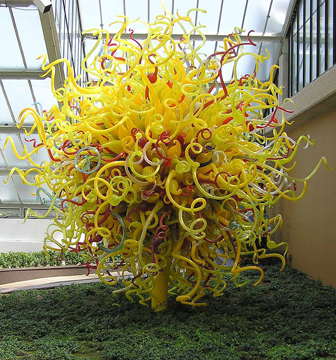
Product Design
The dictum “form follows function” represents an organic approach to three-dimensional design. The products and devices we use everyday continue to serve the same functions but change in styles. This constant realignment in basic form reflects modern aesthetic considerations and, on a larger scale, become artifacts of the popular culture of a given time period.
The two examples below illustrate this idea. Like Tiffany glass, the chair designed by Henry van de Velde in 1895 reflects the Art Nouveau style in its wood construction with organic, stylized lines and curvilinear form. In comparison, the ‘Ant Chair‘ from 1952 retains the basic functional form with more modern design using a triangular leg configuration of tubular steel and a single piece of laminated wood veneer, the cut out shape suggesting the form of a black ant.
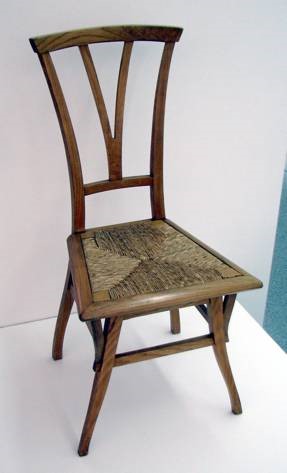

The Most Sculpted Form
The human figure has been the most often reproduced in art. Even modern art with its abstracted forms used the human form most often as its material. There are a few conventions over time that you should be aware of in the depiction of human beings which have varied widely from period to period and from country to country.
Contrapposto
Earlier civilizations like the Egyptians developed a schematic representation of the human form. It never varied for thousands of years (with one exception we will examine in our study of the period) and this was because it was considered to be the most appropriate and necessary form. The figures were rigid and idealized – note the kneecap on Menkaure – but the single foot forward is thought to have been meant to represent life.
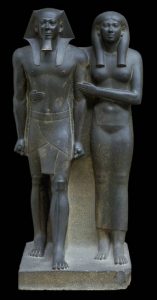
In 1866 an excavation on the Greek Acropolis unearthed a sculpture that would be profoundly influential in the history of art.2 Kritios Boy, so-called, is most likely the image of a young hero created around 480 BCE. Found in pieces and reassembled, this sculpture exhibits the stance of an actual human being which has come to be called contrapposto, or counterbalance.

A contrapposto stance is characterized by a standing figure with the weight on one leg, one hip elevated, and the other bent. More exaggerated contrapposto can involve straight and bent arms and a counterbalance of hips and shoulders. There is usually a pronounced “S” curve down the central axis of a figure in extreme contrapposto.


Michelangelo’s sculpture, originally meant for the tomb of Pope Julius II, exhibits the kind of exaggerated contrapposto that suggests sleep, death or languor.
There are many objects that fit into the category of sculpture, and others – although not strictly sculpture – that are three-dimensional and valued as aesthetic objects. Sometimes it is useful to think about the objects that surround us and look for similar aesthetic qualities in them. We will see how the same impulses to create can be seen in most of the things humans make and even humble objects can be satisfying if the elements and principles are taken into consideration in their making.

